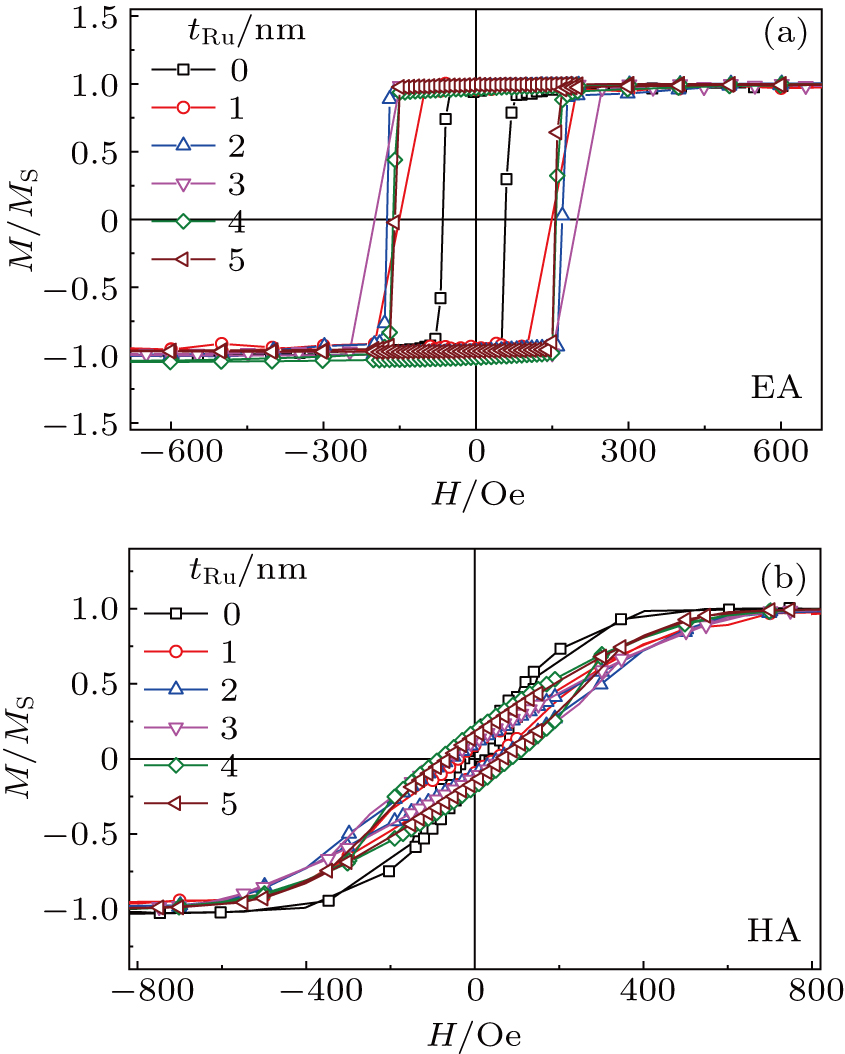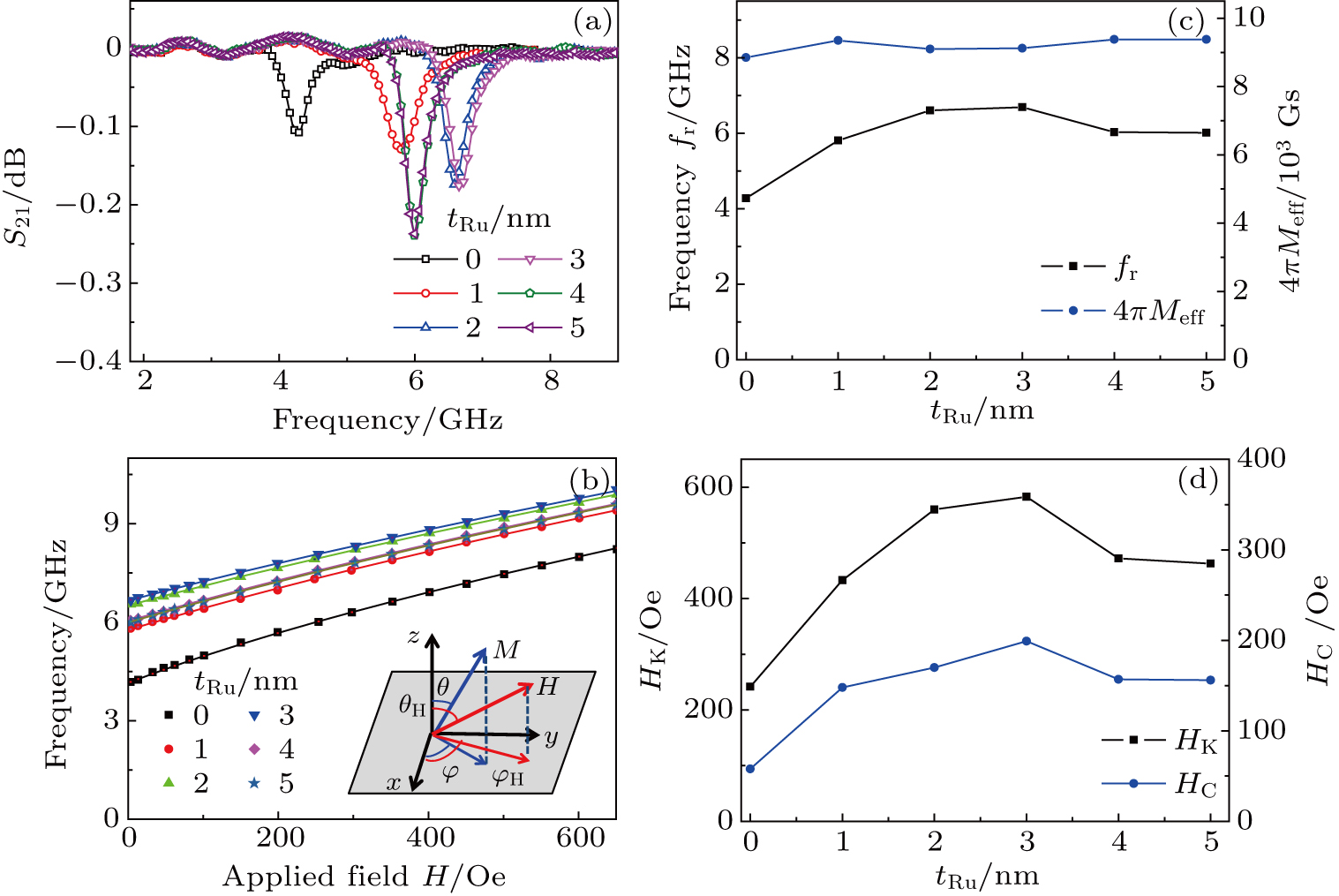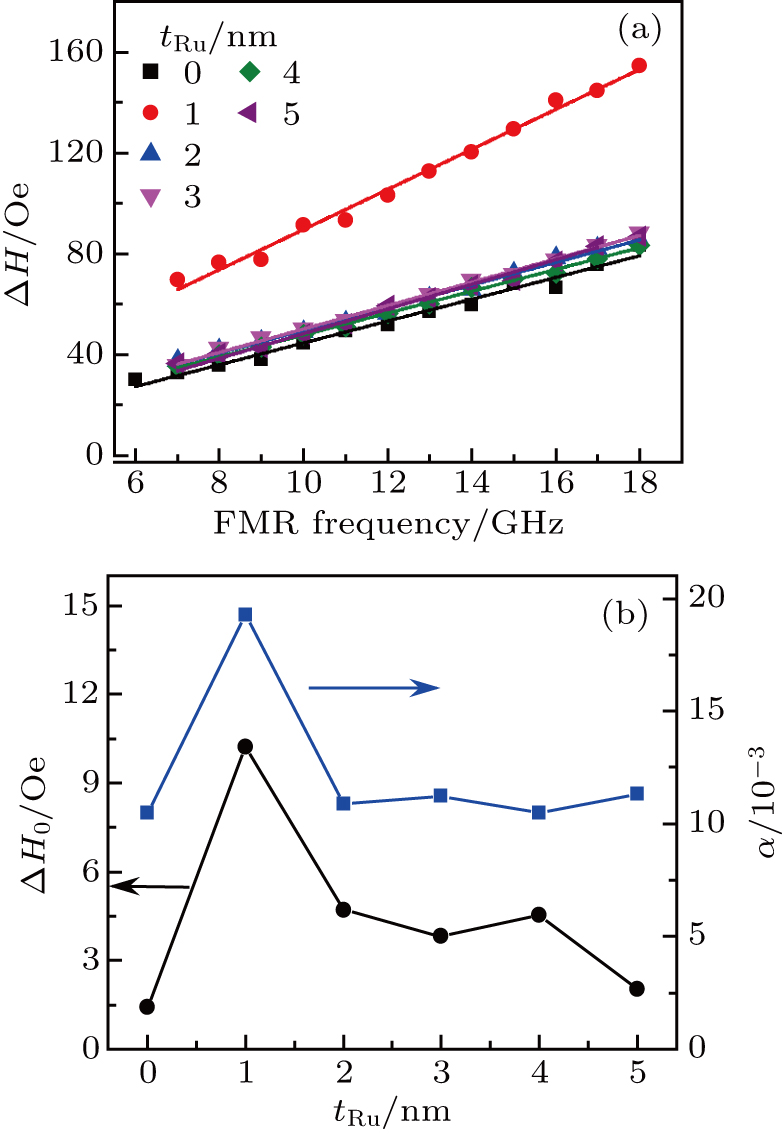1. IntroductionIn the past decades, half-metal Heusler alloys with high spin polarization are widely used in spintronics, such as giant-magnetoresistance spin valves,[1] magnetic tunnel junctions,[2] and spin-transfer torque devices.[3] Recently, with the operation frequency reaching the microwave band, the research interests on the application of Heusler alloy films in microwave devices have been steadily increased.[4–7] We found that Heusler alloy has some unclear areas in the microwave field. Among Heusler alloys, Co2FeSi has fascinated the attention due to its interesting properties such as, high magnetic moment (6 μB) and high Curie temperature (1100 K) along with half metallic band structure.[8]
According the Kittel’s equation,[9] ferromagnetic resonance (FMR) frequency fr of the soft magnetic films (SMFs) at zero bias field can be expressed as

where
γ,
HK, and 4
πMS refer to the gyromagnetic ratio, magnetic anisotropy field, and saturation magnetization of the SMFs, respectively. There are many approaches to improve the zero-field FMR frequency, such as oblique sputtering,
[4,10] composition gradient sputtering (CGS),
[11] magnetoelectric coupling,
[5,12] exchange coupling,
[13–15] interlayer exchange coupled optical mode resonance,
[16,17] inserting a underlayer,
[18–21] etc. Among them, the oblique deposition technique is a simple and easily controllable method to tailor the magnetic anisotropies in magnetic films.
[4] Moreover, a high uniaxial anisotropy can also be induced by Ta, Pt, Cu, Cr or Ru underlayers.
[18–21] Therefore, in this study, a comprehensive study on the oblique sputtering Co
2FeSi films with Ru underlayers in which combining two methods was carried out. It is experimentally demonstrated that both magnetic static and dynamic properties of Co
2FeSi films can be effectively modulated by varying thickness of the Ru underlayer. Maximum magnetic anisotropy field
HK of 582 Oe and
fr of 6.69 GHz were obtained in a sample with 3-nm Ru underlayer. The static and dynamic magnetic properties tunabilities by Ru underlayer are promising to apply Co
2FeSi films in both magnetoresistance device and spintronics microwave devices.
[4] 2. Experimental procedureCo2FeSi films with Ru underlayer were deposited on Si (100) single crystalline substrates by radio frequency (RF) magnetron sputtering system at room temperature using pure Ru and Co2FeSi (atomic ratio Co:Fe:Si = 50:25:25) targets, respectively. The schematic drawing of oblique sputtering device and the geometry of magnetic anisotropy is shown in Fig. 1. Si (100) substrates with dimension of 5 mm × 5 mm × 0.5 mm were pasted on a wedge holder. The angle ϕ between the incoming flux direction and the normal direction of the substrate was defined as the oblique angle, which can be adjusted to optimize the soft magnetic properties of the SMFs. It is revealed that 39° is the optimized oblique angle for Co2FeSi films, which is similar to the report by Xu Zhan.[4] The Ru target approximately faces to the substrate, i.e., with an oblique angle of 0°, so a homogeneous thickness of Ru layer was achieved. In order to study the effect of thickness of Ru underlayer on the soft magnetic properties, a series of Ru thicknesses from 0 nm to 5 nm were deposited. Since the Co2FeSi layer shows a similar high-frequency performance when its thickness is thicker than 20 nm, a thickness around 25 nm was chosen in this study. Due to the nature of oblique sputtering, the prepared Co2FeSi films have a wedge-like thickness distribution from 25.3 nm to 24.2 nm. Fortunately, all the Co2FeSi layers in this study exhibit the identical thickness variation, so the comparison among the corresponding experimental data is reliable. For convenience, the nominal thickness of Co2FeSi films was replaced by 25 nm in this study. The thickness of the thin film was estimated by the deposition time and rate, and verified by an atomic force microscopy (AFM). The baseq pressure of the process chamber was lower than 3 × 10−5 Pa, the working pressure of Ar atmosphere was 0.4 Pa for deposition of Ru and Co2FeSi. The RF powers of 50 W and 45 W were adopted for Co2FeSi and Ru targets, respectively. It should be mentioned here that no protective layer was covered on the top of the Co2FeSi films. For one thing, Co2FeSi Heusler alloy has a good antioxidant capacity. For the other thing, protective caplayer may lead to an extra unknown effect, such as spin sink.
The hysteresis loops were measured by a vibrating sample magnetometer (VSM, Lakeshore 7404). The orientation of the in-plane easy axis (EA) was found to be perpendicular to the thickness gradient direction, while the hard axis (HA) is parallel to it, as illustrated in Fig. 1. The FMR of the samples was measured by a vector network analyzer (VNA, Agilent N5224A) with a co-planar waveguide. The microstructure was characterized by an x-ray diffractometer (XRD) with Cu K α radiation, and the average crystallite size was estimated using Scherrer’s equation.
3. Results and discussionThe XRD spectra of the oblique deposited Co2FeSi thin films were shown in Fig. 2(a). There is a base broad and diffuse peak near around 2θ = 45.60° for all films, no other peaks are observed. In previous researches, if Co2FeSi film has 45.52° (220), 66.22° (400), and 84° (422) diffraction peaks, the structure of film is A2 crystal structure.[22] So the film contains at least a certain amount of A2 phase. But the crystallinity of films is relatively low because the intensities are very small for all films. In addition, no information about Ru is detected in XRD because the Ru underlayer is too thin to be observable.
Average grain sizes of the samples were shown in Fig. 2(b). The average crystallite sizes were estimated using Scherrer’s equation D = Kλ/βcos θ, where β is the width at half maximum of diffraction peak, K = 1 and λ = 0.15406 nm. As illustrated, the grain size of Co2FeSi is rapidly reduced from 46 nm for the Ru-free sample to around 15 nm for the sample with various Ru thicknesses. In other word, the Ru underlayer can effectively reduce the grain sizes of Co2FeSi SMFs. Although the grain size of film without Ru layer is largest, the crystallinity of film is worst because of the weakest peak strength than others.
The hysteresis loops of Co2FeSi films with various thicknesses of Ru underlayers were shown in Fig. 3. The M–H loop of Ru-free Co2FeSi film is very similar to that of Co2FeSi/Si (111) reported by Mohankumar.[8] The M–H loops along EA direction are square with remanence ratio of 100%, while the tilted loops with significantly small remanence appear along the hard axis direction. This fact indicates that the oblique deposited Co2FeSi thin films have obvious uniaxial anisotropy. The loop along HA direction of the film with 3-nm Ru underlayer has the maximum saturation field, which implies that in-plane uniaxial anisotropic field reaches the maximum when the thickness of Ru is 3 nm. In addition, the coercivity is enlarged by Ru underlayer although the grain size of Co2FeSi film is reduced by Ru underlayer. It is well known that the intrinsic stress of thin films is attributable to the accumulation of crystallographic defects during deposition.[23,24] For Co2FeSi film without Ru underlayer, the “self shadowing” effect of the oblique sputtering produces a compressive stress, which makes the easy axis direction of the film perpendicular to the direction of the sputtering beam, as shown in Fig. 1. The magnitude of the internal stress is affected by Ru underlayer because it is closely related to the grain size, composition, growth texture, growth morphology (whether the film is grown in columnar fashion or as equiaxial crystallites), and thickness of the film, and so on.[25] It has been reported that the stress induced by lattice deformation has an intimate correlation with the coercivity of FeCo film, and has an influence on the soft magnetic properties via magnetoelastic anisotropy.[26–28] A high HK of 500 Oe was obtained after inserting 5-nm Ru underlayer between the substract and FeCoB layer.[27,28] The origin of high magnetic anisotropy of FeCoB films with a Ru underlayer is the residual stress that appears as the distorted lattices and their directional texture. Therefore, it is reasonable that the increment of magnetic anisotropy field HK and coercivity HC due to the Ru underlayer in this study can be attributed to the induction of large magneto-elastic anisotropy by the internal stress. At the Ru thickness of 3 nm, HC and HK of Co2FeSi film reach the individual maximum due to the largest internal stress.
For Ru/Co2FeSi system, the internal stress induced in-plane anisotropy in this study can be demonstrated by the following theoretical simulation. Given the in-plane anisotropy is induced by internal stress, the total free energy density will include the Zeeman energy, the shape anisotropy energy and in-plane anisotropic energy used for the sample is

where
Ku is the in-plane uniaxial anisotropy constant, the easy axis of such anisotropy is taken to be along the
x axis;
H is the external applied field,
θ and
θH are the angles with
z axis for magnetization and applied field in spherical coordinates, respectively; and
φ and
φH are the azimuthal angles with
x axis for magnetization and applied field (see Fig.
4(b) inset). Note that, at equilibrium, due to the strong demagnetizing field of the thin films and to the fact the applied magnetic field is in plane,
θ =
θH =
π/2. According to the Smit–Beljers relation, the FMR frequency
ωr can be expressed as follows:
[29]

At equilibrium, the above formula can be simplified as

where
γ/2
π = 2.8MHz/Oe is the gyromagnetic ratio, 4
π Meff is the effective saturation magnetization,
HK is the in-plane uniaxial anisotropic field,
Hr is the in-plane resonance field. The values of 4
π Meff were obtained by taking
φ =
φH = 0 into Eq. (
4) fitting the experimental data.
Figure 4(a) shows some typical scattering parameter S21 curves at self-bias state with H = 0 Oe, representing the FMR absorption capability of the Ru(x nm)/Co2FeSi films. The frequency dependence of the resonance fields for films with different thickness of Ru underlayer were shown in Fig. 4(b). It can be seen that the fitting data completely agree with the experimental ones, indicating the anisotropy field is induced by the Ru-thickness-dependent stress. As illustrated in Fig. 4(c), the self-bias FMR frequency is dramatically enhanced from 4.28 GHz for Ru-free Co2FeSi film to 6.69 GHz for Ru thickness of 3 nm with an increment of 56%. The values of 4π Meff for all samples with Ru thickness are slightly different, but all the values are around 9000 Gs (1 Gs = 10−4 T). In literature,[30] the maximum magnetization value of MgO/Cr(30 nm)/Co2FeSi(30 nm) is 10000 Gs which is smaller than that of the bulk case (14650 Gs with L21 structure[31]), and the reason was attributed to a certain amount of atomic site disorder. In addition, Hazra et al. found that the structure of 50-nm annealed Co2FeSi film at 450 °C was A2 crystal structure and the magnetization of that was 11200 Gs.[22] The values of magnetization of our films are slightly lower than the value of the literature.[22,30] It can be attributed to two reasons: (i) the film contains a certain amount of A2 phase as observed from XRD peak [Fig. 2(a)]. Atomic sites are more disordered. (ii) The thickness of our films is about 25 nm which is smaller than that of the film in literature.[30] The calculated values of HK and the values of HC obtained from EA M–H loop are summarized in Fig. 4(d). It is worth noting that HK does not increase monotonously with increasing thickness of Ru. Instead, it initially increases from 242 Oe to 582 Oe with increasing thickness of Ru from 0 nm to 3 nm, and then decreases to 472 Oe and 463 Oe at Ru thickness of 4 nm and 5 nm, respectively. The behavior of FMR frequency is similar to HK. So the increasing of FMR frequency is mainly dominated by in-plane uniaxial anisotropic field. It is obviously that HK and HC have similar trend. The coercivity and the anisotropy reach the maximum at 3 nm of Ru, and then decrease slightly. This can be attributed to that they are all affected by in-plane stress of thin films.[27,28,32] The maximum internal stress will be produced in the film after inserting 3-nm Ru underlayer. It is well known that in-plane magnetic anisotropy could be well induced by the internal stress. In previous report,[32] 0.6-GPa tensile stress was obtained for FeCo film after inserting Co underlayer. A residual stress of 0.75 GPa was achieved for 200-nm FeCoB film after inserting a Ru layer between FeCoB film and substrate.[27] A high in-plane magnetic anisotropy field 500 Oe induced by compressive stress was achieved in the films.[28] So, larger in-plane magnetic anisotropy field HK induced by the internal stress is obtained after inserting Ru underlayer as shown in Fig. 4(d).
To explore the damping property of the samples, ferromagnetic resonance spectra were recorded over the range of 6 GHz–18 GHz. For each excitation frequency, the FMR measurement was carried out along the EA direction by magnetic field scan till the sufficient high field. The ΔH refers to the peak-to-peak linewidth of FMR curves. The FMR linewidth as a function of frequency ΔH(f) for various thicknesses of Ru underlayer was shown in Fig. 5(a). The relationship of ΔH and f is perfectly linear, indicating the intrinsic origin of damping for the samples. The lines were fitting with the following equation:[33]

where the first term at right is the intrinsic contribution to FMR linewidth, which is proportional to Gilbert’s damping constant
α, and
γ' =
γ/2
π = 2.8 MHz/Oe. Δ
H0 is the inhomogeneous broadening of the resonance field, which depends on the film quality and approaches to zero for the best samples.
[34] Δ
H0 of film and the effective Gilbert coefficient damping parameters of films with different thickness of Ru were shown in Fig.
5(b). According to Fig.
5(b), Δ
H0 of film and the effective Gilbert coefficient damping parameter of film with 1-nm Ru underlayer are larger than that of other samples. The damping constant
α for films with different Ru thickness except 1 nm are nearly constant (
α ≈ 0.011) which is slightly larger than 0.008 of MgO (substrate)/Cr/Co
2FeSi film which was L2
1 structure.
[31] It is well known that the effective Gilbert coefficient includes both intrinsic and extrinsic contributions. The extrinsic contribution may originate from various sources such as magnetic inhomogeneity within the material, the distributions of magnitude and direction of the effective demagnetization field
et al.[31,35] We can be attributed the behavior of our samples to the inhomogeneity of the magnetization and anisotropies, which is influenced by the interface of the Ru and Co
2FeSi. At the Ru film thickness of 1 nm, the Ru islands are discontinuous and can not cover the surface of the Si surface which induced larger Δ
H0 and damping. This behavior just likes that in Cu/Py/Cu/Pt in which Pt layer is discontinuous layer at 1 nm.
[35] When Ru thickness is larger than 1 nm, a continuous Ru layer is formed and entirely cover on the surface of Si surface. This result implies that the continuous interface between Ru and Co
2FeSi induces a large in-plane anisotropic field without introducing additional external damping. The damping is mainly the intrinsic damping term which comes only from the intrinsic damping of the material. This also shows that adding Ru underlayer is a better way to enhance the frequency of ferromagnetic resonance for oblique sputtering Co
2FeSi film.











